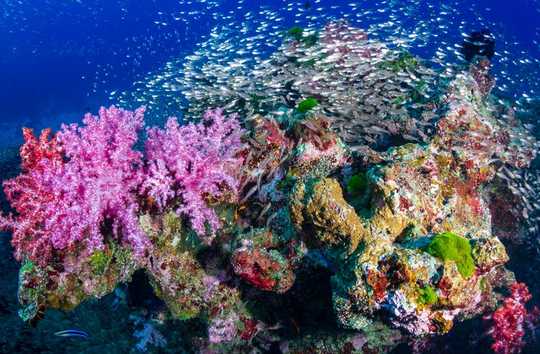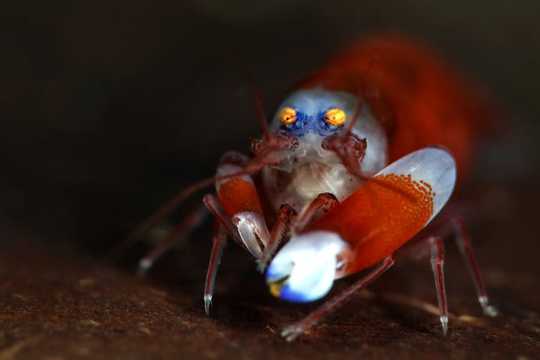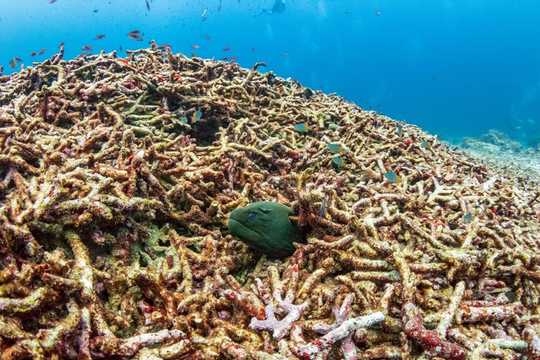 A coral reef in the Similan Islands, Thailand. (Shutterstock)
A coral reef in the Similan Islands, Thailand. (Shutterstock)
The ocean is a vast, quiet place, right? Vast, yes; quiet, not so much.
As a researcher who studies coral reefs, I’ve floated above many and, when I listen closely, my ears are invariably filled with sounds. There might be the sound of small waves breaking on the beach and coral rubble rolling on the sand as the waves retreat. Beyond the sound of water, there is something quieter.
For some people, these faint noises sound like the snap, crackle and pop of breakfast cereal when milk hits it; for others, they are reminiscent of frying bacon.
Whatever the analogy, they are natural reef sounds, and noisy reefs are a very good thing. So good, in fact, that we might be able to use the sound of healthy coral reefs to improve the quickly increasing number of degraded ones.
For the past three decades, rising ocean temperatures have put the world’s coral reefs under a great deal of stress. Extreme events can kill large portions of a reef in a short time. For example, 29 per cent of Great Barrier Reef corals died during the the 2016 marine heatwave. It can take 15-25 years for a reef to recover from a bleaching event.
Who’s making the noise?
The noise makers on coral reefs include all manner of fishes and invertebrates. Coral reef fishes produce a wide range of low-frequency pops, grunts, gurgles and croaks while they feed, fight, court and mate. In fact, much like birds, some fish species sing at dawn and dusk, and sometimes through the night, in underwater choruses.
High-frequency sounds tend to be produced by invertebrates. Of these, snapping shrimps are the winners in terms of pitch and loudness. Snapping shrimps have one enlarged claw that, due to a marvel of anatomy and physics, makes an audible snap when closed rapidly.
 The modest snapping shrimp. (Shutterstock)
The modest snapping shrimp. (Shutterstock)
If you had your ear next to the tiny crustacean, the sound could reach 190 decibels, louder than any jet plane taking off. Luckily, no one will ever be that close since these shrimps live deeply ensconced in coral crevices, snapping away day and night.
Why is sound important?
Most coral reef animals spend the early part of their lives as tiny larvae floating in the water. This larval period can last from a few days to several weeks, moving a few metres to hundreds of kilometres from where it was born.
For those long-distance dispersers, the ability to find a new home in the vastness of the ocean is critical. Three decades ago, scientists thought that larval fish were transported at the whim of currents; settling onto a new piece of real estate was largely a matter of chance.
We know better now. Reef fish larvae are able to see, hear and smell reef habitat, and to swim quite competently towards it.
Scientists have submerged light traps, known to catch fish larvae attracted to light, with a nearby underwater speaker that plays the sounds of reefs, other habitats or nothing at all. They have built small mounds of coral rock to cover speakers playing sounds, or introduced a tiny fish larva to a chamber with contrasting sound recordings, to see which sound it prefers and swims toward.
These studies show that many larval reef fish are attracted to the sounds of a live reef. Light traps and rubble heaps that play reef noise catch far more larvae than when no reef noise is played. They also catch larvae of more species and more families.
Reef noise can also repel some fish larvae, perhaps because it reveals that there are too many predators or too few potential shoal mates. These species settle in places with sounds they dislike the least, rather than like the most.
What do reef sounds reveal?
Reef sounds reveal a lot about the state of the coral reef. Louder coral reefs, dominated by low-frequency sounds, tend to be in good health: they have more coral, more fish, more large invertebrates and are more architecturally complex, with lots of caves and crevices.
In contrast, coral reefs with more high-frequency noises tend to be in worse shape: they have more dead coral, more seaweed and fewer fishes.
 A moray eel pokes its head out of a pile of bleached, dead coral on a damaged tropical reef. (Shutterstock)
A moray eel pokes its head out of a pile of bleached, dead coral on a damaged tropical reef. (Shutterstock)
Coral reefs with a mixture of high- and low-frequency sounds have a larger variety of fish species. Reefs in marine protected areas have complex acoustic signatures like that, as did those on the Great Barrier Reef before a series of recent storms and mass coral bleaching. Degraded Australian coral reefs are now quieter and less attractive to larvae looking to settle down.
The underwater soundscape is critical for a fish larva to know whether there is a coral reef nearby, and whether that reef is a good place to settle. But some species have better hearing than others, and the depth and structure of the habitat can also affect the way sounds emanate from the reef.
Can we use sound to repopulate degraded reefs?
It’s an obvious step to go from knowing that natural sounds are important for fish recruitment to using those same sounds to actively attract fish to depleted reefs.
A recent experiment tested this idea and found it promising. Twice as many fish, across all the major feeding groups, settled on coral-rubble reefs that played the sounds of healthy reefs than on similar but silent reefs. Healthy sounding reefs also attracted 50 per cent more species.
This suggests that acoustic enrichment could be a new and potentially powerful tool to help build up fish communities on unhealthy coral reefs. The authors warned it has to be used alongside interventions to tackle the causes of coral reef decline, climate change in particular.
Without these simultaneous actions, using an attractive soundtrack to invite small fish onto degraded reefs that offer little food or shelter would be false advertisement. And that never ends well for the fooled party.
About The Author
Isabelle Côté, Professor of Marine Ecology, Simon Fraser University
This article is republished from The Conversation under a Creative Commons license. Read the original article.
Related Books
Climate Adaptation Finance and Investment in California
by Jesse M. Keenan This book serves as a guide for local governments and private enterprises as they navigate the unchartered waters of investing in climate change adaptation and resilience. This book serves not only as a resource guide for identifying potential funding sources but also as a roadmap for asset management and public finance processes. It highlights practical synergies between funding mechanisms, as well as the conflicts that may arise between varying interests and strategies. While the main focus of this work is on the State of California, this book offers broader insights for how states, local governments and private enterprises can take those critical first steps in investing in society’s collective adaptation to climate change. Available On Amazon
This book serves as a guide for local governments and private enterprises as they navigate the unchartered waters of investing in climate change adaptation and resilience. This book serves not only as a resource guide for identifying potential funding sources but also as a roadmap for asset management and public finance processes. It highlights practical synergies between funding mechanisms, as well as the conflicts that may arise between varying interests and strategies. While the main focus of this work is on the State of California, this book offers broader insights for how states, local governments and private enterprises can take those critical first steps in investing in society’s collective adaptation to climate change. Available On Amazon
Nature-Based Solutions to Climate Change Adaptation in Urban Areas: Linkages between Science, Policy and Practice
by Nadja Kabisch, Horst Korn, Jutta Stadler, Aletta Bonn This open access book brings together research findings and experiences from science, policy and practice to highlight and debate the importance of nature-based solutions to climate change adaptation in urban areas. Emphasis is given to the potential of nature-based approaches to create multiple-benefits for society.
This open access book brings together research findings and experiences from science, policy and practice to highlight and debate the importance of nature-based solutions to climate change adaptation in urban areas. Emphasis is given to the potential of nature-based approaches to create multiple-benefits for society.
The expert contributions present recommendations for creating synergies between ongoing policy processes, scientific programmes and practical implementation of climate change and nature conservation measures in global urban areas. Available On Amazon
A Critical Approach to Climate Change Adaptation: Discourses, Policies and Practices
by Silja Klepp, Libertad Chavez-Rodriguez This edited volume brings together critical research on climate change adaptation discourses, policies, and practices from a multi-disciplinary perspective. Drawing on examples from countries including Colombia, Mexico, Canada, Germany, Russia, Tanzania, Indonesia, and the Pacific Islands, the chapters describe how adaptation measures are interpreted, transformed, and implemented at grassroots level and how these measures are changing or interfering with power relations, legal pluralismm and local (ecological) knowledge. As a whole, the book challenges established perspectives of climate change adaptation by taking into account issues of cultural diversity, environmental justicem and human rights, as well as feminist or intersectional approaches. This innovative approach allows for analyses of the new configurations of knowledge and power that are evolving in the name of climate change adaptation. Available On Amazon
This edited volume brings together critical research on climate change adaptation discourses, policies, and practices from a multi-disciplinary perspective. Drawing on examples from countries including Colombia, Mexico, Canada, Germany, Russia, Tanzania, Indonesia, and the Pacific Islands, the chapters describe how adaptation measures are interpreted, transformed, and implemented at grassroots level and how these measures are changing or interfering with power relations, legal pluralismm and local (ecological) knowledge. As a whole, the book challenges established perspectives of climate change adaptation by taking into account issues of cultural diversity, environmental justicem and human rights, as well as feminist or intersectional approaches. This innovative approach allows for analyses of the new configurations of knowledge and power that are evolving in the name of climate change adaptation. Available On Amazon
From The Publisher:
Purchases on Amazon go to defray the cost of bringing you InnerSelf.comelf.com, MightyNatural.com, and ClimateImpactNews.com at no cost and without advertisers that track your browsing habits. Even if you click on a link but don't buy these selected products, anything else you buy in that same visit on Amazon pays us a small commission. There is no additional cost to you, so please contribute to the effort. You can also use this link to use to Amazon at any time so you can help support our efforts.
























